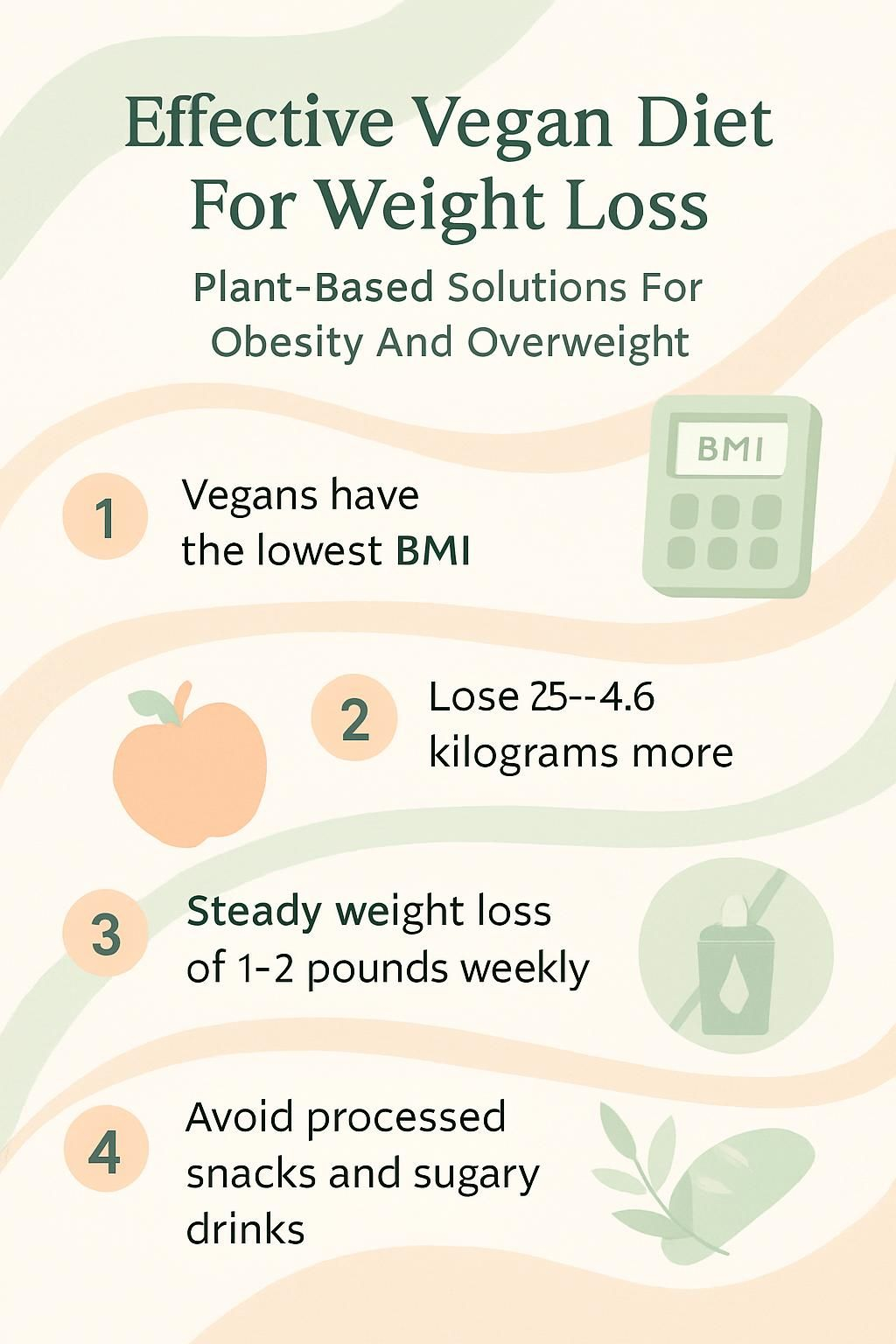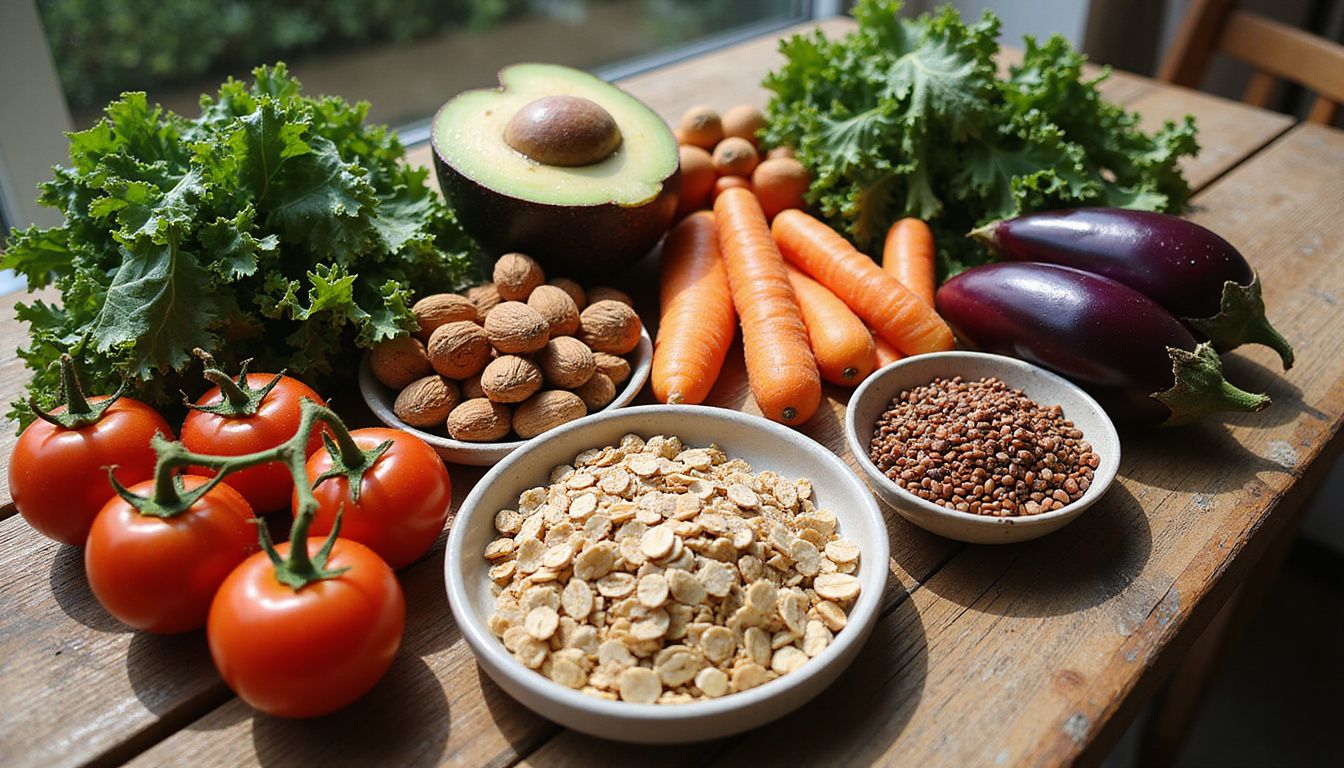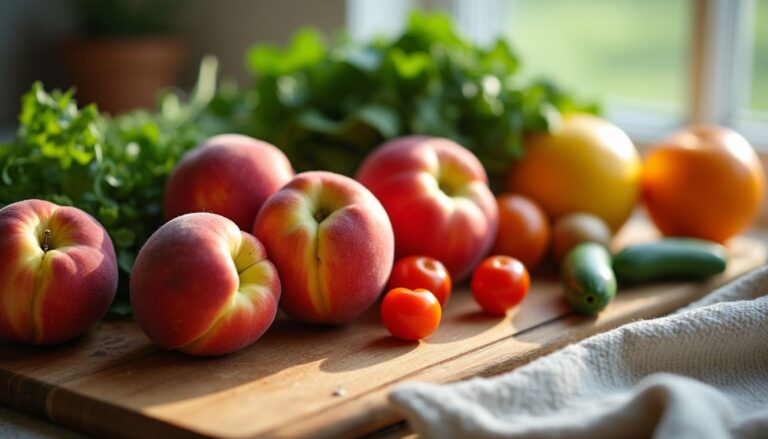Effective Vegan Diet For Weight Loss: Plant-Based Solutions For Obesity And Overweight
Our Nutrition Assistant AI Suite will transform your body. You will lose fat, get toned, and build muscle. Gain confidence and optimal health.
If you live with obesity or are overweight and want a safe plan to lose weight, a vegan diet can help. Only a small share of people in the United States follow a strictly plant-based diet, yet the approach is practical and backed by research.
This guide explains what a vegan diet includes, how plant-based food helps with weight management, and simple steps you can use today. Small, steady changes add up to lasting results.
Key Takeaways
- Large cohort studies, such as Adventist Health Study and EPIC-Oxford, report the lowest BMI in vegans and less age-related weight gain than in omnivores.
- Meta-analyses show vegan diets lead to 2.5 to 4.6 kilograms more weight loss than meat-based or vegetarian diets over several weeks to months.
- Plant foods are high in fiber and lower in calories and saturated fat. This improves fullness and supports a steady loss of about 1 to 2 pounds per week.
- Limit ultra-processed vegan snacks, added oils, and sugary drinks. They can raise calories fast even without animal products.
- A well-planned vegan pattern built on whole grains, legumes, vegetables, fruits, nuts, and seeds supports healthy weight and lowers risk of cardiovascular disease and type 2 diabetes.

What Is a Vegan Diet and How Is It Different From Other Diets?

A vegan diet removes all animal products and centers on plant-based nutrition. This simple shift can support weight control, a healthy weight range, and lower rates of overweight and obesity over time.
What Does a Vegan Diet Include?
Vegan eating excludes meat, poultry, fish, eggs, dairy, honey, gelatin, and some additives from insects like carmine or cochineal. Certain beers and wines may use animal-based clarifiers, so labels matter.
Your plate will feature fruits, vegetables, whole grains such as brown rice or oats, legumes including beans and lentils, nuts like almonds or walnuts, and seeds like chia or flax. Choose soy, almond, oat, hemp, or coconut beverages instead of cow’s milk.
Protein comes from plants rather than meat or dairy. Useful options include tofu and tempeh, seitan made from wheat gluten, peas, beans, edamame, lentils, quinoa, and plant protein powders if needed.
Vegan does not mean only salads. Cooked grains and hearty stews can be filling without animal fat. Some compounds found in animal foods, such as creatine, carnitine, and taurine, are limited or absent in plants. These support muscle, fat metabolism, and heart function. A registered dietitian can advise on supplements if your needs are higher.
I switched to a vegan diet last year for weight loss. Eating more plants lowered my calories, and I still felt satisfied.— Sarah M., 32
How Is a Vegan Diet Different From Vegetarian or Other Diets?
Vegans avoid all animal products including dairy, eggs, and honey. Vegetarians skip meat and poultry but may eat eggs and dairy. Pesco-vegetarians include fish. Semi-vegetarians eat meat occasionally. Omnivores include all foods.
In the Adventist Health Study, vegan participants had the lowest BMI. EPIC-Oxford reported less weight gain with age in vegans compared with people who eat animal products more often.
Reading labels helps because many packaged foods contain milk powder or egg ingredients. On a vegan plan, protein comes from beans, tofu, lentils, whole grains like barley or millet, and seeds such as chia or flax.
This pattern is naturally high in dietary fiber and lower in saturated fat. That combination helps support heart health and steady weight management, as shown in large observational research.
How Does a Vegan Diet Help With Weight Loss?
A vegan diet and weight loss often align since plant foods usually carry fewer calories and more fiber. Controlled trials and reviews show that a plant-based diet can help you lose more weight than diets that include meat and dairy products.
Why Does a Vegan Diet Reduce Calorie Intake?
Whole plant foods like vegetables, beans, and grains have a low calorie density. You can eat larger portions for fewer calories, which makes adherence easier.
Skipping meat and high-fat dairy reduces saturated fat and total calories. Fiber from plants boosts fullness, so you are satisfied longer. Cutting about 500 to 1,000 calories per day typically supports a safe loss of 1 to 2 pounds per week.
Groups that emphasize plant-based foods tend to lose more weight than groups eating meat and dairy.
How Does High Fiber Help You Feel Full?
Fiber adds bulk and slows digestion. Fruits, vegetables, whole grains, and legumes steady your blood sugar and help control cravings.
This approach shifts you away from calorie-dense snacks like cookies or French fries. Diets rich in fiber support weight maintenance by improving satiety without extra calories. Higher fiber intake also benefits gut health and lowers risk for cardiovascular disease and type 2 diabetes.
What Is the Effect of Low Saturated Fat on Weight?
Vegan patterns are usually lower in saturated fat and cholesterol. Eating less saturated fat can reduce total calorie intake and help with weight control.
Research from the American College of Lifestyle Medicine notes greater BMI reductions with plant-based eating compared with many other diet groups. Choosing vegetables, whole grains, legumes, nuts, seeds, and fruits supports a healthy metabolism while you limit high saturated fat oils and animal fats.
Scientific Evidence Supporting Plant-Based Solutions for Obesity
Evidence links plant-based diets with lower body weight and fewer cases of obesity. Results are consistent across cohort studies, trials, and meta-analyses.
What Studies Show Vegan Diets Aid Weight Loss?
A 2022 review in Frontiers in Nutrition found plant-based diets reduced body weight and improved heart and blood pressure measures. In 15 trials analyzed by Barnard and colleagues, average weight loss reached 3.4 kg in intention-to-treat and 4.6 kg in completers.
Huang’s meta-analysis of 12 studies showed people on vegan diets lost about 2.5 kg more than non-vegetarians. Vegetarian diets also lowered body weight compared with meat-inclusive diets, but the effect was smaller.
EPIC-PANACEA linked higher meat intake, about 250 grams per day, with approximately 2 kg of weight gain over five years. A large study in Taiwan found a lower rate of obesity in vegetarians than in non-vegetarians across nearly 50,000 adults.
Trials like New DIETs and VA BEACH also reported greater success when participants emphasized whole plant foods rather than processed Western-style meals.
How Does a Vegan Diet Affect BMI and Metabolism?
Across several cohorts, vegans had the lowest BMI, followed by vegetarians, then omnivores. People eating mostly plant foods had lower rates of overweight and obesity.
Whole grains, legumes, fruits, and vegetables deliver fiber with fewer calories, which improves satiety. Some studies also suggest higher resting metabolic rate with higher fiber intake, which may support weight control.
These findings match outcomes seen in large observational studies. Diet patterns rich in plant foods are linked with lower BMI and healthier metabolic markers than those that include higher amounts of meat and eggs.
Essential Components of an Effective Vegan Diet for Weight Loss
An effective vegan diet for weight loss focuses on whole foods, balance, and consistency. Quality choices help you lose weight and keep it off while meeting your nutrition needs.
Why Focus on Whole, Plant-Based Foods?
Whole plant foods like fruits, leafy vegetables, legumes, nuts, seeds, and whole grains are rich in fiber and lower in calories. Higher fiber keeps you full longer and helps prevent overeating.
Research on vegan diets shows people often lose more weight than those on moderate low-fat diets or typical mixed diets. Processed vegan snacks may seem convenient, but many contain added sugars and oils that slow progress.
Choose fresh fruit, raw vegetables with hummus, or a handful of nuts for snacks. Many people report better energy and mood after swapping packaged foods for whole grains and dark leafy greens.
Data reference: a 22-week low-fat vegan program in adults showed meaningful reductions in body weight.
How to Ensure Adequate Protein Intake?
Meet protein needs with lentils, tofu, tempeh, seitan, edamame, beans, quinoa, and plant protein powders if helpful. This supports fullness and muscle during weight loss.
Pay attention to essential amino acids, which your body cannot make. Lysine is abundant in legumes. Methionine is higher in grains like brown rice and oats. Tryptophan is found in seeds, nuts, and beans. Combine legumes and grains over the day for a complete mix.
Some compounds common in animal foods, like creatine and carnitine, are limited in plants. If you have high training demands or medical needs, seek advice from a dietitian or healthcare provider.
Essential Amino Acid Food Sources Table
| Amino Acid | Helpful Vegan Sources |
|---|---|
| Lysine | Lentils, soybeans, edamame, wheat germ, pumpkin seeds |
| Methionine | Brown rice, quinoa, barley, oats, sesame seeds |
| Tryptophan | Chia seeds, sunflower seeds, chickpeas, peanuts |
What Healthy Fats Support Satiety and Hormone Balance?
Healthy fats help you feel satisfied and support hormone production, which affects stress, metabolism, and circulation. Choose avocados, nuts like almonds and walnuts, chia seeds, flaxseeds, hemp seeds, and small amounts of olive oil.
Try half an avocado on a salad or a tablespoon of ground flax in oatmeal. Many people find that swapping processed oils for whole nuts improves fullness and enjoyment.
Summary Table
| Food Source | Type of Fat | Main Benefit | Example Serving |
|---|---|---|---|
| Avocado | Monounsaturated | Enhances fullness | Half a fruit |
| Walnuts or almonds | Poly and monounsaturated | Supports heart health | 1 ounce, about a small handful |
| Chia or flax seeds | Omega-3 ALA | Helps balance hormones | 1 tablespoon ground |
| Olive oil | Monounsaturated | Helps absorb fat-soluble vitamins | 1 teaspoon |
What Foods Should You Include in a Vegan Weight Loss Plan?
A strong vegan weight loss plan centers on low calorie density and high nutrient density. Choose foods that reduce calories while delivering vitamins, minerals, and protein.
Which Fruits and Vegetables Are Best?
Load up on high-fiber, low-calorie vegetables such as cucumbers, beets, broccoli, cauliflower, zucchini, tomatoes, and large green salads. Dark leafy greens like spinach and kale offer many nutrients for very few calories.
Pick fruits with more fiber per bite, such as blackberries, raspberries, plums, and oranges. These help you stay full with fewer total calories than many tropical fruits.
What Whole Grains and Legumes Are Recommended?
Choose whole grains like quinoa, oatmeal, brown rice, millet, barley, corn, rye, sorghum, teff, and triticale. These have more fiber than refined grains and support steady energy.
Add legumes for protein and satiety. Use edamame in stir-fries or salads. Add white beans to soups, chickpeas to curries or as roasted snacks, and black beans with grains for filling bowls. Lentils cook quickly and supply iron and magnesium.
Which Nuts, Seeds, and Plant-Based Proteins Are Beneficial?
Pumpkin seeds, almonds, and natural peanut butter support fullness and provide protein. About one ounce of pumpkin seeds has roughly 7 grams of protein, and almonds offer around 6 grams.
Tofu, tempeh, hummus, seitan, and plant protein powders can help you meet daily goals. For example, one cup of cooked tempeh provides about 31 grams of protein. Half a cup of firm tofu has around 10 grams.
These foods also deliver iron, zinc, and healthy fats that support weight management and overall nutrition.
What Foods Should You Limit or Avoid on a Vegan Weight Loss Diet?
Some plant-based items can stall progress when eaten often. Learning what to limit prevents hidden calorie creep and helps you reach your goal.
Why Limit Processed Vegan Foods?
Packaged cookies, chips, and some meat substitutes are often high in refined starches, oils, sodium, and added sugars. These raise calories without offering the same fullness or nutrients as whole foods.
Studies link ultra-processed foods with more weight gain. People who focus on whole plant foods, such as beans and greens, tend to lose more weight than those leaning on processed options.
Build meals from fruits, vegetables, legumes, and whole grains most of the time. Keep convenience items for rare use, not daily staples.
What Are the Risks of Excessive Plant-Based Oils and Sugary Drinks?
Oils are calorie dense. Even a small pour can add many calories. Use measured amounts to support hormone health without overshooting your calorie target.
Sugary drinks such as sweetened plant milks, flavored coffees, and sodas add fast calories with little nutrition. Higher intake is linked to higher body mass index, which can slow your progress.
Key Data Table
| Food or Drink | Typical Calories | Main Concern |
|---|---|---|
| Olive oil | About 120 per tablespoon | High calorie load |
| Coconut oil | About 117 per tablespoon | High in saturated fat |
| Vegan soda | About 150 per can | Added sugar |
| Sweetened oat milk | About 70 to 130 per cup | Added sugar |
Prioritize nutrient-dense foods like beans, vegetables, whole grains, and unsweetened beverages to keep calories in balance.
What Does a Sample Vegan Weight Loss Meal Plan Look Like?
A simple structure makes eating well easier. Here is a sample approach that balances calories, protein, and fiber without feeling restrictive.
What Is a Healthy Breakfast Option?
Two vegan pancakes with a quarter cup of blackberries and one tablespoon of peanut butter total about 296 calories. This mix of whole grains, fruit, and nut protein keeps you full.
Another option is one third cup of a quinoa and chia oatmeal mix with about one and a quarter cups of unsweetened soy milk, also around 296 calories. Batch-cook pancakes and freeze them to save time later in the week.
What Should You Eat for Lunch?
Build lunches around fiber and protein. Four cups of a white bean and veggie salad come in near 360 calories. A green salad with edamame and beets of similar size lands near 325 calories.
A veggie and hummus sandwich is another balanced choice at about 325 calories. Meals like these help you stay energized without overeating later.
What Are Good Dinner Choices?
Choose dinners that combine vegetables, whole grains, and plant protein. A falafel salad with lemon-tahini dressing is about 499 calories. Two cups of a black bean and quinoa bowl total around 500 calories. Spaghetti squash with peanut sauce and edamame is close to 525 calories.
These meals offer fiber, protein, and healthy fats that support satiety and keep calories in check.
What Snacks Support Weight Loss?
Smart snacks can bridge hunger without blowing your calorie budget. Aim for protein and fiber.
- Three quarters of a cup of edamame pods, about 150 calories
- Two tablespoons of pumpkin seeds, about 114 calories
- One small plum, about 30 calories
- Two cups of air-popped popcorn, about 62 calories
- Two celery stalks with a quarter cup of hummus, about 100 calories
Measure snacks once or twice to learn portions. That small habit prevents accidental overeating.
How Can You Succeed on a Vegan Weight Loss Journey?
Success comes from planning, tracking, and patience. Set up your week, monitor intake, and keep your goals realistic.
How to Plan and Prepare Meals Effectively?
Plan a week of meals that match your calorie needs and schedule. Prep easy breakfasts like overnight oats. Cook a pot of grains on Sunday, then portion for fast lunches and dinners.
Store dry mixes and cooked staples in clear containers. Use a simple planner or app to track what you prepped and what to buy. Planning adds variety across fruits, legumes, whole grains, nuts, and seeds, which supports balanced nutrition and better portion control.
How to Monitor Your Calorie Intake?
Use a food diary or mobile app to log meals. Many tools let you scan barcodes and check serving sizes. A common target for weight loss is a daily calorie goal that supports about 1 to 2 pounds per week, adjusted for your age, sex, height, weight, and activity level.
Check labels for calories and serving sizes, even on vegan foods. Watch hidden calories in oils, dressings, and sweetened drinks. People who track their intake tend to lose more weight than those who do not, according to research from the Journal of the Academy of Nutrition and Dietetics.
How to Stay Consistent and Patient?
Set realistic expectations. Aiming for 1 to 2 pounds per week is safe and more sustainable. Build a simple meal rhythm, rely on whole plant foods, and keep high-fiber produce in every meal.
Track progress with weekly photos or a brief journal entry. If your weight plateaus, review portions, oils, and snack choices. Consistency beat perfection for most people. Small wins add up.
What Are the Additional Benefits of a Vegan Diet Beyond Weight Loss?
Plant-based eating supports more than the number on the scale. Many people see gains in heart health, blood sugar control, and digestion.
How Does a Vegan Diet Improve Heart Health?
Vegan patterns lower saturated fat and contain no dietary cholesterol. Replacing animal products with fruits, vegetables, whole grains, and legumes can reduce LDL cholesterol, the type linked to artery plaque.
A 2019 review found that plant-forward diets were associated with a lower risk of death from cardiovascular disease. Plant foods are rich in antioxidants and phytochemicals that protect blood vessels and support healthy blood pressure.
How Does It Lower the Risk of Chronic Diseases?
Whole plant foods are packed with fiber, vitamins, and minerals that support the immune system and reduce inflammation. This can lower risk for type 2 diabetes and some cancers.
Losing even 5 percent of your body weight can reduce risk for heart disease and diabetes. Many people also report steadier energy and better lab markers within a few months.
How Does It Enhance Digestive Health?
Fiber feeds helpful gut bacteria and supports regularity. These microbes produce short-chain fatty acids that protect the gut lining and may help with nutrient absorption.
Many people notice less bloating and more regular bowel habits after shifting to high-fiber plant meals such as beans, oats, and leafy greens.
What Are Common Challenges on a Vegan Diet and How to Overcome Them?
Every change brings challenges. With a plan, you can address common sticking points and stay on track.
How to Address Protein Deficiency Concerns?
Include a mix of legumes, soy foods, whole grains, nuts, and seeds each day. This variety covers essential amino acids and supports recovery from exercise.
Monitor other key nutrients that can be lower in plant patterns, such as vitamin B12, iron, calcium, iodine, zinc, and omega-3s. A dietitian can personalize supplements based on your labs and goals.
How to Handle Social and Dining Challenges?
Check menus online and call ahead to confirm vegan choices. Bring a portable snack in case options are limited.
Tell friends or event hosts about your needs. Offer to bring a dish to share, such as a bean salad or roasted vegetables. Joining local or online vegan groups can give you quick meal ideas and social support.
What Is the Role of Physical Activity in Enhancing Weight Loss?
Diet sets the stage. Physical activity helps you burn calories, maintain muscle, and feel your best.
Why Is Regular Exercise Important?
Regular activity increases calorie burn and helps protect muscle while you lose fat. The CDC suggests at least 150 minutes per week of moderate exercise for adults.
Cardio such as brisk walking or cycling strengthens your heart and can improve blood pressure and cholesterol. Many people also find exercise lowers stress and reduces cravings.
How to Combine Cardio and Strength Training?
Pair activities you enjoy, like walking or cycling, with two days per week of strength work. Use bodyweight moves such as squats, lunges, and push-ups or light dumbbells.
Rotate cardio and strength to stay fresh and prevent plateaus. Short, consistent sessions often beat long, rare workouts.
When Should You Consult Professionals for Personalized Guidance?
Personal health needs vary. Professional support can fine-tune your vegan meal plan and improve your results.
How Can Dietitians and Nutritionists Help?
Registered dietitians can tailor your calorie target, protein plan, and micronutrient needs. They also help you build practical meal routines around your schedule and preferences.
Clinicians trained in lifestyle medicine use current research to guide weight management. This support reduces guesswork and keeps your plan balanced and sustainable.
How to Address Specific Health Needs?
If you have diabetes, thyroid issues, or other conditions, talk with your healthcare provider before making big diet changes. You may need to track vitamin B12, iron, calcium, omega-3s, and protein more closely.
Regular blood tests can spot gaps early. If you take medicines that affect appetite or blood sugar, ask your care team for guidance on calorie targets and timing.
What Are Some Success Stories and Case Studies of Vegan Weight Loss?
Real people have used a plant-based diet to make steady progress. These experiences show the approach can fit daily life.
What Are Real-Life Examples of Vegan Weight Loss Journeys?
Reshma lost 30 pounds in five months using a whole-food vegan plan that aimed for 1 to 2 pounds per week. Even with a few slips at social events, her energy improved and progress continued.
In a six-month study of 63 adults, participants who adopted vegan or vegetarian patterns lost more weight than those who stayed with omnivorous diets. In another 22-week program for adults with type 2 diabetes, plant-based eating improved diet quality more than standard advice.
Conclusion
A plant-based, vegan diet offers a clear path to weight loss and better health. You get more fiber, fewer calories from saturated fat, and a wide range of nutrients by focusing on whole plant foods.
Studies consistently link plant-based diets with lower BMI and improved metabolic health. Build meals from fruits, vegetables, legumes, whole grains, nuts, and seeds. Plan ahead, limit ultra-processed items and sugary drinks, and measure oils.
Fill key nutrient gaps with smart food choices and, if needed, supplements such as vitamin B12. With consistent habits and help from professionals when needed, you can reach and maintain a healthy weight using a practical vegan approach.
Health disclaimer: This content is for education only and is not medical advice. Consult a qualified healthcare professional for personal guidance.
FAQs
1. What is an effective vegan diet for weight loss and how does it help with obesity?
A plant-based eating plan for weight loss focuses on whole grains, legumes, fruits, and vegetables. These foods are low in calories but high in fiber and nutrients. Studies show that people who follow a plant-based approach often have lower body mass index scores compared to those who eat animal products.
2. Are there specific foods I should include or avoid on a vegan diet for managing overweight?
Include beans, lentils, leafy greens, oats, berries, nuts (in moderation), and seeds. Limit processed snacks like chips or cookies made without animal ingredients since they can still be high in sugar or fat.
3. How much weight can someone lose by switching to a plant-based solution for obesity?
Research suggests that adults following a well-planned vegan meal pattern may lose between 5 to 10 pounds over several months when combined with regular activity. Results vary based on calorie intake and physical movement levels.
4. Can you share a personal example of success using this method?
After adopting more whole grains and fresh produce while reducing oil-rich meals from my daily routine, I noticed improved energy within weeks along with gradual weight reduction of about six pounds over two months.
Summary: A balanced vegan eating style supports healthy weight management through nutrient-dense choices such as beans and vegetables; limiting processed options helps maximize benefits according to research findings.







